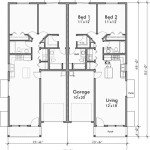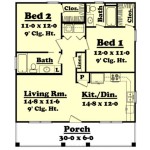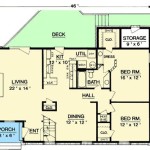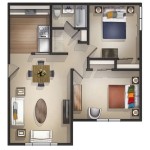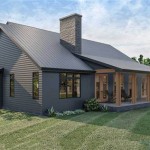Floor Plans For A One Story House: A Comprehensive Guide
One-story house plans, often referred to as ranch-style homes, offer a variety of benefits and considerations for potential homeowners. These designs prioritize accessibility, simplified maintenance, and often foster a stronger connection to the surrounding landscape. This article will delve into the key aspects of one-story house floor plans, exploring their advantages, disadvantages, design considerations, and popular layouts.
Advantages of One-Story House Plans
One of the primary advantages of a single-story home is its enhanced accessibility. The absence of stairs makes these designs ideal for individuals with mobility challenges, families with young children, and those planning to age in place. The lack of stairs eliminates a significant fall risk, contributing to a safer living environment for all occupants. Moving furniture and household items is also significantly easier when there are no stairs to navigate.
Another benefit is the simplified maintenance associated with a single-level structure. Exterior tasks like window cleaning, gutter maintenance, and roof repairs are generally easier and safer to perform on a one-story home. Interior cleaning and repairs are also simplified due to the absence of multiple levels. Plumbing and electrical systems are typically more straightforward to access and maintain, potentially reducing long-term maintenance costs.
One-story homes also tend to promote a stronger connection to the outdoors. The horizontal layout allows for greater access to yards, patios, and gardens. Multiple entry points and expansive windows can seamlessly integrate indoor and outdoor living spaces. This is particularly appealing for individuals who value outdoor activities and enjoy spending time in nature.
Finally, one-story homes can often be more energy efficient than multi-story homes, particularly in climates with extreme temperature fluctuations. Heat rises, so in a multi-story home, warmth tends to accumulate on the upper levels, making it more difficult to regulate temperature evenly. In a single-story home, temperature distribution is generally more consistent, reducing the need for excessive heating or cooling.
Disadvantages of One-Story House Plans
While offering numerous advantages, one-story house plans also present some potential drawbacks that should be carefully considered. One of the primary challenges is the larger footprint required to accommodate the same square footage as a multi-story home. This can result in a higher land cost, particularly in areas where land is expensive or limited. The increased lot size also translates to more extensive landscaping and potentially higher property taxes.
Privacy can also be a concern in single-story homes, especially in densely populated areas. With all living spaces on the same level, it can be more difficult to create distinct zones for privacy and quiet. Careful planning of the floor plan is essential to minimize noise transfer between rooms and to buffer living spaces from street noise or activity in neighboring yards. Strategic landscaping and window placement can further enhance privacy.
Another potential disadvantage is the limited opportunity for views. In a multi-story home, upper levels often offer panoramic views of the surrounding landscape. One-story homes, situated closer to the ground, may have limited sightlines, especially in areas with dense vegetation or neighboring buildings. This may be a significant consideration for individuals who value elevated views.
Finally, one-story homes can sometimes feel less spacious than multi-story homes with the same square footage. The horizontal layout can create a sense of sprawlingness, but it can also make rooms feel smaller and less defined. High ceilings and open floor plans can help to mitigate this effect, but careful attention to space planning is essential to maximize the perceived spaciousness of a single-story home.
Key Design Considerations for One-Story House Floor Plans
Effective floor plan design is crucial to maximizing the functionality and comfort of a one-story home. Several key considerations should guide the design process. One of the most important factors is optimizing the flow of traffic throughout the house. The layout should facilitate easy movement between rooms and minimize bottlenecks. A well-designed floor plan will minimize the need to walk through one room to access another, creating a more efficient and comfortable living environment.
Another important consideration is zoning. The floor plan should clearly delineate different zones for living, sleeping, and entertaining. This can be achieved through the strategic placement of walls, partitions, or changes in floor level. Separating bedrooms from common living areas can help to reduce noise transfer and enhance privacy. Clearly defining zones can also improve the overall organization and functionality of the home.
Natural light is another critical element of effective one-story house design. Maximizing natural light can make rooms feel brighter, more spacious, and more inviting. Large windows, skylights, and strategically placed doors can bring natural light into the interior spaces. The orientation of the house on the lot should also be considered to maximize sunlight exposure. South- facing windows, for example, can capture sunlight during the winter months, helping to reduce heating costs.
Accessibility is a paramount design consideration, particularly for homeowners who are planning to age in place or who have mobility challenges. Wide doorways, level thresholds, and accessible bathrooms are essential features. Universal design principles should be incorporated throughout the house to ensure that it is accessible and usable by people of all ages and abilities. Features such as grab bars, adjustable countertops, and roll-in showers can significantly enhance accessibility.
Popular One-Story House Floor Plan Layouts
Several popular one-story house floor plan layouts cater to different lifestyles and preferences. The open floor plan, characterized by a seamless flow between living spaces, is a popular choice for modern homes. This layout typically combines the living room, dining room, and kitchen into a single, large space, promoting social interaction and creating a sense of spaciousness. Open floor plans are well-suited for entertaining and for families who value togetherness.
The split bedroom plan is another common layout, designed to enhance privacy. In this configuration, the master bedroom is located on one side of the house, while the secondary bedrooms are situated on the opposite side. This arrangement provides a buffer between the master suite and the children's bedrooms, creating a more private and quiet retreat. Split bedroom plans are often favored by families with young children or teenagers.
The L-shaped floor plan is a versatile option that can be adapted to a variety of lot shapes and sizes. This layout typically features a central living area with wings extending to either side. One wing often houses the bedrooms, while the other wing contains the kitchen, dining room, and garage. L-shaped floor plans can create a more private and secluded outdoor space, such as a patio or courtyard, in the crook of the "L."
The U-shaped floor plan is similar to the L-shaped plan, but it features three wings instead of two. This layout often creates a central courtyard that is enclosed on three sides, providing a protected and private outdoor living space. U-shaped floor plans are well-suited for maximizing natural light and ventilation, as the courtyard can act as a light well and allow for cross-ventilation throughout the house.
Another layout that is gaining popularity is the courtyard plan. Typically, this plan has the home built around a central courtyard. Courtyard plans offer a high degree of privacy and security, as the courtyard is often enclosed by walls or fences. This layout is well-suited for creating a secluded outdoor living space and for maximizing natural light and ventilation. Courtyard plans are often found in warmer climates, where outdoor living is a year-round activity.
The bungalow floor plan, often associated with Craftsman-style homes, is characterized by its compact size and efficient use of space. Bungalows typically feature a simple, rectangular layout with a central living area and bedrooms arranged along one side. These homes often have large front porches and overhanging eaves, providing shade and enhancing curb appeal. Bungalow floor plans are well-suited for small families or individuals who prefer a cozy and low-maintenance living environment.

Unique One Story House Plans Monster

Must Have One Story Open Floor Plans Blog Eplans Com

Pin On Homes

40 X 55 2 200 Sf One Story House Plan The Escape

Stylish One Story House Plans Blog Eplans Com

Single Story House Floor Plans Y New

Elegant One Story Home 6994 4 Bedrooms And 2 Baths The House Designers

Unique One Story House Plans Monster

Small One Story 2 Bedroom Retirement House Plans Houseplans Blog Com

One Story House Plan Examples



